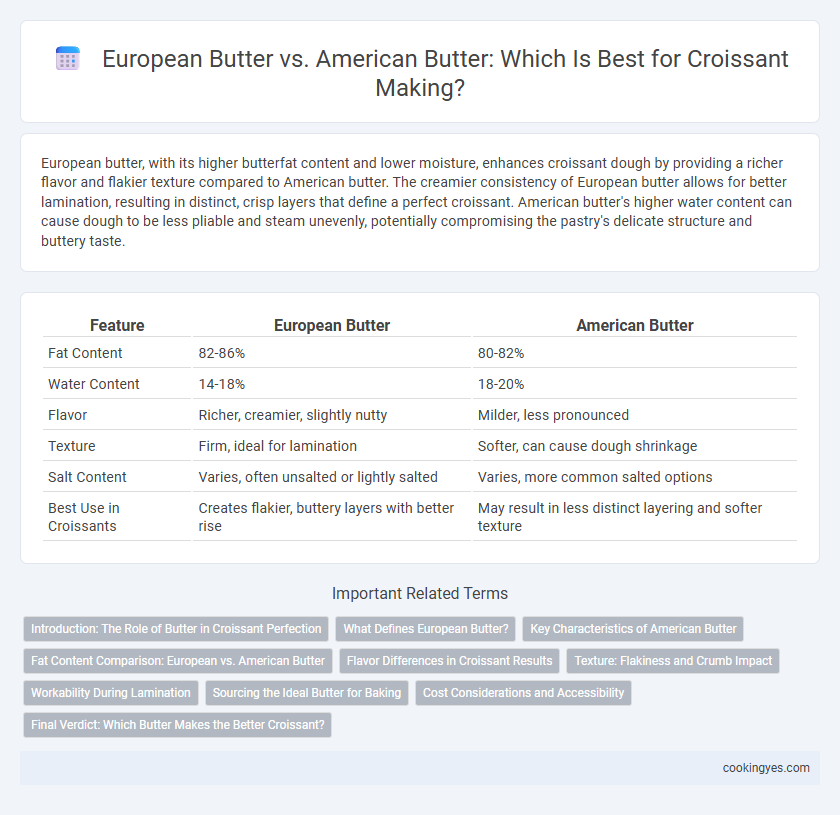European butter, with its higher butterfat content and lower moisture, enhances croissant dough by providing a richer flavor and flakier texture compared to American butter. The creamier consistency of European butter allows for better lamination, resulting in distinct, crisp layers that define a perfect croissant. American butter's higher water content can cause dough to be less pliable and steam unevenly, potentially compromising the pastry's delicate structure and buttery taste.
Table of Comparison
| Feature | European Butter | American Butter |
|---|---|---|
| Fat Content | 82-86% | 80-82% |
| Water Content | 14-18% | 18-20% |
| Flavor | Richer, creamier, slightly nutty | Milder, less pronounced |
| Texture | Firm, ideal for lamination | Softer, can cause dough shrinkage |
| Salt Content | Varies, often unsalted or lightly salted | Varies, more common salted options |
| Best Use in Croissants | Creates flakier, buttery layers with better rise | May result in less distinct layering and softer texture |
Introduction: The Role of Butter in Croissant Perfection
European butter, known for its higher fat content (82-85%) and lower water percentage, delivers superior flakiness and richer flavor in croissants compared to American butter, which typically contains 80% fat. The distinct creaminess and moisture balance of European butter facilitate delicate lamination layers, essential for the croissant's signature airy, tender crumb and golden crust. Selecting high-quality European butter enhances texture and taste, making it the preferred choice for artisanal croissant baking.
What Defines European Butter?
European butter is characterized by its higher butterfat content, typically ranging from 82% to 86%, compared to American butter's standard 80%, which contributes to a richer flavor and creamier texture essential for croissant making. It is often cultured, meaning it undergoes a fermentation process that develops a tangy complexity, enhancing the buttery taste and aroma in pastries. The distinct moisture content and firmness of European butter improve dough lamination, resulting in flakier, more delicate croissants with a golden, crisp crust.
Key Characteristics of American Butter
American butter used in croissant making typically contains a higher water content, around 15-18%, compared to European butter's 16-17%, influencing dough hydration and layering. Its slightly lower fat content, usually around 80%, affects the flakiness and richness of the croissant, often resulting in a less tender crumb. The milder flavor profile of American butter offers a subtler buttery taste, which can be balanced with additional ingredients during baking for desired flavor intensity.
Fat Content Comparison: European vs. American Butter
European butter typically contains 82-85% fat, which contributes to the rich, flaky texture essential for croissant making, whereas American butter averages around 80% fat. The higher fat content in European butter results in better dough elasticity and enhanced flavor development, producing superior layers and flakiness in croissants. American butter's lower fat and higher moisture content can lead to less pronounced layering and a denser pastry texture.
Flavor Differences in Croissant Results
European butter, known for its higher fat content (typically 82-86%) and lower water percentage, imparts a richer, creamier flavor and flakier texture to croissants compared to American butter, which usually contains around 80% fat. The cultured European butter enhances the croissant's complexity with subtle tangy and nutty notes, creating a more indulgent eating experience. In contrast, American butter's milder taste can result in a less pronounced buttery flavor and a slightly softer, less layered pastry.
Texture: Flakiness and Crumb Impact
European butter's higher fat content (82-85%) compared to American butter (80-82%) enhances croissant flakiness by creating thinner, more delicate layers during lamination. The lower water content in European butter reduces steam generation, resulting in a tender crumb with less gumminess. American butter's higher moisture can cause dough shrinkage and less defined layers, affecting the classic flaky texture characteristic of traditional croissants.
Workability During Lamination
European butter, with its higher fat content (82-85%) and lower water percentage, offers superior workability during croissant lamination by creating distinct, even layers that result in enhanced flakiness. In contrast, American butter typically contains more water (around 80% fat) which can cause dough to become soggy and difficult to handle, compromising the lamination process. The consistency and plasticity of European butter make it the preferred choice for achieving delicate, crisp croissant layers through precise lamination.
Sourcing the Ideal Butter for Baking
European butter, with its higher fat content typically ranging from 82% to 85%, offers superior flavor and flakiness ideal for croissant making, compared to American butter which usually contains around 80% fat. Sourcing authentic European butter such as French beurre d'Isigny or Danish Lurpak ensures consistent moisture control and a rich, creamy taste essential for perfect lamination. Bakers prioritize European butter for its lower water content and optimal melting point, which enhances the layered structure and golden crust in croissants.
Cost Considerations and Accessibility
European butter, renowned for its higher fat content (typically 82-85%), is preferred for croissant making due to its superior flavor and flakiness but often comes at a premium price compared to American butter, which usually contains around 80% fat. The cost difference can impact production budgets, especially for artisanal bakeries seeking authentic taste without sacrificing affordability. While European butter can be less accessible in certain regions, American butter offers a more readily available and cost-effective alternative, making it a practical choice for large-scale croissant production.
Final Verdict: Which Butter Makes the Better Croissant?
European butter, with its higher fat content (82-86%) and lower moisture levels, produces flakier, richer croissants with superior flavor compared to American butter, which typically contains 80% fat. The enhanced butter quality in European varieties contributes to better lamination and more consistent browning during baking, resulting in a crispier crust and tender crumb. For professional bakers and enthusiasts aiming for authentic croissant texture and taste, choosing European butter is the preferred option.
European Butter vs American Butter for Croissant Making Infographic

 cookingyes.com
cookingyes.com